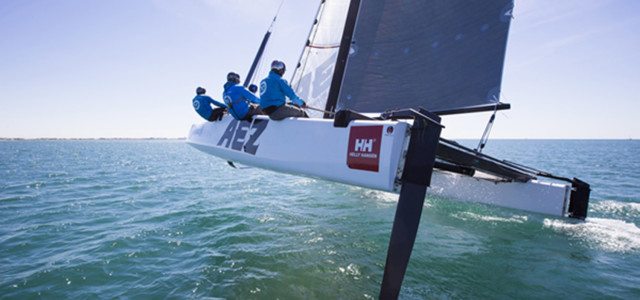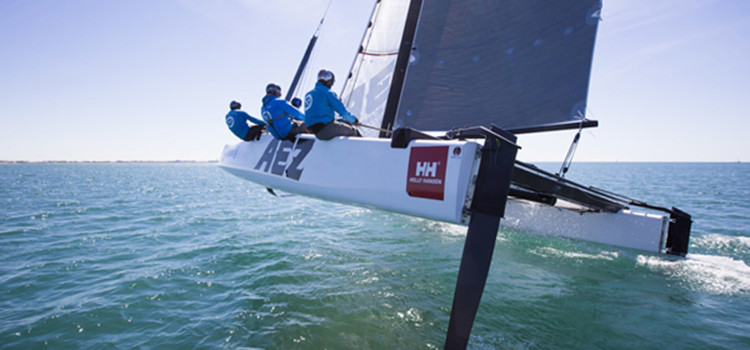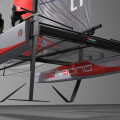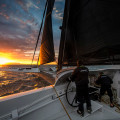

The Great Cup, GC32 MK2 goes foiling
EnglishGC32In evidenzaMultiscafiVela 14 Maggio 2014 Zerogradinord 0

La Grande Motte – After six months of intense R&D, the GC32 has been fitted with its Mk2 set of foils and has now joined the twin-hulled elite – like the AC72s of the last America’s Cup – in becoming a fully foiling, airborne, racing catamaran.
The Martin Fischer design, in production at Premier Composite Technologies in Dubai, had its first sailing season last year. Then it was fitted with L-shaped rudders and double-S shaped main lifting foils, which, above 15 knots, typically held 80% of the boat’s displacement. New state of the art T-shaped rudders and J-shaped main lifting foils now enable the GC32 to sail clear of the water.
With its new foils fitted, the GC32 has been undergoing sea trials in La Grande Motte in the south of France with spectacular results. So far the boat has proved able to foil in as little as 8 knots of wind and impressively can do so not only downwind, but upwind too – something that was rarely seen on the AC72s, until Oracle Team USA mastered it during the 34th America’s Cup itself. But most impressive is that the GC32 can foil stably, with almost no hobby horsing or porpoising.
Also, while the AC72 crews had to bust their guts as they wrestled their powerful craft around the race course – principally because of the constant grinding necessary to keep pressure in the hydraulics operating the wingsail and the foils – on the GC32 there is nothing like the same athletic requirement: there are no hydraulics and the rig uses conventional soft sails.
The helm on the GC32 has proved to be well balanced and while it takes some minimal liaison between helmsman and mainsail trimmer to get up on the foils, to ‘get in the groove’ and then to remain there, the boat is surprisingly easy to sail even for a crew of average ability. In short, you don’t need Olympic medals or to have spent decades racing catamarans to get foiling in the GC32.
Despite being well-mannered, the GC32 still delivers unprecedented performance. After just two weeks of sailing, the boat has been foiling upwind at more than 20 knots in less than 10 knots of breeze and recorded 27 knots downwind in the same conditions. On one subsequent run the boat averaged 30 knots over four minutes. And these numbers are just from the preliminary trials – speeds approaching those of ORMA 60 trimarans a decade ago, all achieved under full main and jib alone, without using the gennaker, from a boat almost half the length, that can be demounted and trailered home after racing!
How is this possible?
The key to the GC32’s combined high performance and foiling stability, lies in its latest generation foils. In profile these resemble the foils used on the AC72s which form a V-shape when lowered and then incline inwards when raised, turning the ‘V’ into a discreet ‘L’ shape. However the significant difference with the GC32’s foils compared to the AC72s’ – which were developed for San Francisco’s strong conditions – is that the former are substantially larger relative to boat size. In fact the 1.6m long horizontal lifting part of the GC32’s foils is the same length as some of the smallest foils Cup teams were developing for their AC72s.
But this is where the similarity ends. The GC32 foils are substantially higher aspect (ie their chord and thickness is much less for their length). This approach maximises the foils’ vital lift to drag ratio and this, combined with their span, is what enables them to operate so effectively in low wind strengths.
In terms of their lineage, the foils are the latest iteration of those developed for Franck Cammas’ International C-Class Catamaran Championship winner Groupama C (for which Martin Fischer was part of the design team) and the Fischer-designed Flying Phantom F18, originally the Groupama team’s test platform for its C-Class catamaran.
Further refinement of the GC32 foil’s design has since taken place in conjunction with the GC32’s project manager, Andrew Macpherson, former Alinghi engineer Brett Ellis and Laurent Tournier of the foils’ builder, Heol Composites. The result is foils very close to the limit of what it is currently possible to build in composites.
Heave stability
L-foil boardsThe stability of the ride when foiling is partly due to the size of the foils, but also their design. The V-shape the main lifting foils form when fully lowered encourages them to auto-stabilise: The faster the boat goes, the more the foil lifts out of the water and the less lift it provides. Conversely as boat speed lowers, so more of the foil drops into the water, exposing a greater surface of foil, which provides more lift. The end result is good ‘heave stability’ and minimal porpoising.
The design of the latest foils also addresses more subtle aspects such as the effect leeway has on them and how their bending characteristics affect performance.
“It has been a long winter because making it fly was pretty ambitious,” admits Laurent Lenne, the Amsterdam-based French entrepreneur, who is creator and owner of the GC32 class. “We want a state of the art product and if everyone is flying in the America’s Cup, then we had to do that too.”
“The first time we sailed the boat was very, very tense and it was a huge relief when we flew straight away. But these are fifth or sixth generation foils, following on from all the work done with Groupama and the Flying Phantom, so we knew we weren’t starting from scratch. To nail it from day one – we were very happy with that.”
“We wanted to have a very stable boat allowing people to fly very easily and even when you are doing 27 knots, it is a picnic on board. In terms of how the boat behaves, it is very stable, but it is still very, very fast.”
VIP guests
Helping work up the GC32 with her new foils has been former Luna Rossa crewman, Paul Campbell-James, currently helming the Gazprom Team Russia catamaran on the Extreme Sailing Series, where he is a two-time series winner.
“The most amazing thing is that we’ve been fully foiling upwind and downwind in 8-10 knots of breeze – it is amazingly fast and really easy,” he says. “The tips on the foils are huge and so there is massive amounts of lift available at all times, which is pretty useful. It possibly limits top speed when it is windier, but in order to be able to foil all the way around the track in 8-10 knots of breeze is pretty unbelievable.”
“The boat is very stiff, which is good for foiling and the foil design seems very good. It was all just amazingly easy.”
Oracle Team USA coach, Philippe Presti was also down for the trials.
“I think they did a good job,” says Presti of the GC32 team’s efforts. “I know the time it took to make, for example, the AC45 foil properly and these guys got it right almost on the first shot.”
Presti was present for two days of the trials, the first in stronger conditions when the GC32 averaged 32.5 knots for one five second burst. The second day was lighter and in 14 knots she was making 18-19 knots upwind at around 50deg.
“It is early days for these boats. By just trimming the sails and the foil you would improve the performance by quite a lot. I think the tool is great. Off the shelf, it is pretty impressive.”
According to Presti the take-off boat speed of Oracle Team USA’s AC72 was 23 knots – this compares with around 15-16 knots for the GC32.
In terms of wind strength… “I would say you need 12 knots to foil upwind, but you can definitely foil upwind from 10-12 knots to the top of the range. Downwind, you can foil pretty low – it depends if you are sailing with the big genniker, but you can foil in 7-8 knots.”




No comments so far.
Be first to leave comment below.